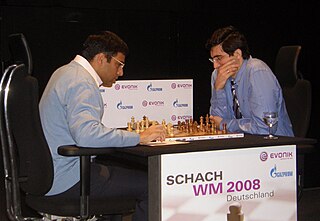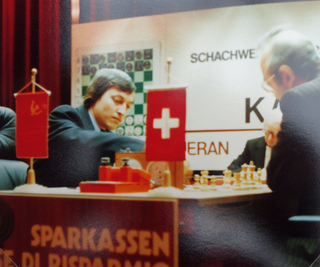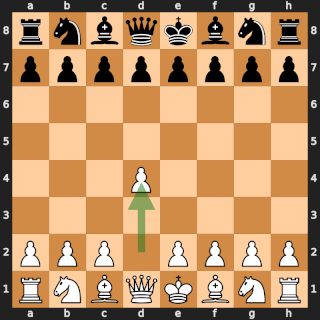The Pirc Defence is a chess opening characterised by the response of Black to 1.e4 with 1...d6 and 2...Nf6, followed by ...g6 and ...Bg7, while allowing White to establish a centre with pawns on d4 and e4. It is named after the Slovenian grandmaster Vasja Pirc.

The FIDE World Chess Championship 2004 was held at the Almahary Hotel in Tripoli, Libya, from June 18 to July 13, 2004.
The Najdorf Variation of the Sicilian Defence is one of the most popular, reputable, and deeply studied of all chess openings. Modern Chess Openings calls it the "Cadillac" or "Rolls-Royce" of chess openings. The opening is named after the Polish-Argentine grandmaster Miguel Najdorf, although he was not the first strong player to play the variation. Many players have relied on the Najdorf.
The Catalan Opening is a chess opening where White plays d4 and c4 and fianchettoes the white bishop on g2. A common opening sequence is 1.d4 Nf6 2.c4 e6 3.g3, although various other openings can transpose into the Catalan. The Encyclopaedia of Chess Openings (ECO) lists codes E01–E09 for lines with 1.d4 Nf6 2.c4 e6 3.g3 d5 4.Bg2; other lines are part of E00.
Triangulation is a tactic used in chess to put one's opponent in zugzwang. Triangulation is also called losing a tempo or losing a move.
In chess, the Scheveningen Variation of the Sicilian Defence is an opening that is a line of the Open Sicilian characterised by Black setting up a "small centre" with pawns on d6 and e6. There are numerous move orders that reach the Scheveningen; a common one is:

The World Chess Championship 2006 was a match between Classical World Chess Champion Vladimir Kramnik and FIDE World Chess Champion Veselin Topalov. The title of World Chess Champion had been split for 13 years. This match, played between September 23 and October 13, 2006, in Elista, Kalmykia, Russia, was to reunite the two World Chess Champion titles and produce an undisputed World Champion.
The London System is an opening system in chess where White opens with 1.d4 and develops the dark-squared bishop to f4, then supports the d4-pawn with pawns on e3 and c3. The other bishop is developed to d3 and the knights typically to f3 and d2. This set-up often results in a closed game. The London System can be used against virtually any Black defence and thus comprises a smaller body of opening theory than many other openings. Although it has a reputation as a solid opening, the London System has faced criticism for its tedious nature and lack of dynamic play.

Deep Blue versus Garry Kasparov was a pair of six-game chess matches between then-world chess champion Garry Kasparov and an IBM supercomputer called Deep Blue. Kasparov won the first match, held in Philadelphia in 1996, by 4–2. Deep Blue won a 1997 rematch held in New York City by 3½–2½. The second match was the first defeat of a reigning world chess champion by a computer under tournament conditions, and was the subject of a documentary film, Game Over: Kasparov and the Machine.

The World Chess Championship 2008 was a best-of-twelve-games match between the incumbent World Chess Champion, Viswanathan Anand, and the previous World Champion, Vladimir Kramnik. Kramnik had been granted a match after not winning the World Chess Championship 2007 tournament.

The World Chess Championship 2010 match pitted the defending world champion, Viswanathan Anand, against challenger Veselin Topalov, for the title of World Chess Champion. The match took place in Sofia, Bulgaria from 24 April to 13 May 2010, with a prize fund of 2 million euros. Anand won the final game to win the match 6½–5½ and retain the title.

The World Chess Championship 2012 was a chess match between the defending World Champion Viswanathan Anand of India and Boris Gelfand of Israel, winner of the 2011 Candidates Tournament. After sixteen games, including four rapid games, Anand retained his title. The match, held under the auspices of the World Chess Federation FIDE, took place between 10 and 31 May 2012 in the Engineering Building of the State Tretyakov Gallery, Moscow, Russia. The prize fund was US$2.55 million.

The 1978 World Chess Championship was played between Anatoly Karpov and Viktor Korchnoi in Baguio, Philippines, from July 18 to October 18, 1978. Karpov won, thereby retaining the title.

The 1981 World Chess Championship was played between Anatoly Karpov and Viktor Korchnoi in Merano, Italy from October 1 to November 19, 1981. Karpov won with six wins against two, with 10 draws. The two players had already played against each other in the World Chess Championship match 1978 in the Philippines, when Karpov also won.

The World Chess Championship 2014 was a match between the world champion Magnus Carlsen and challenger Viswanathan Anand, to determine the World Chess Champion. It was held from 7 to 25 November 2014, under the auspices of the World Chess Federation (FIDE) in Sochi, Russia.

Rotlewi versus Rubinstein is a game of chess played between Gersz Rotlewi and Akiba Rubinstein in Łódź, Poland on December 26, 1907. It features a brilliant queen and rook sacrifice by Rubinstein to force mate.
The 17th season of the Top Chess Engine Championship began on 2 January 2020 and ended on 22 April 2020. TCEC Season 16 3rd-place finisher Leela Chess Zero won the championship, defeating the defending champion Stockfish 52.5-47.5 in the superfinal.
The 18th season of the Top Chess Engine Championship began on 4 May 2020 and ended on 3 July 2020. The defending champion was Leela Chess Zero, which defeated Stockfish in the previous season's superfinal. The two season 17 superfinalists qualified again for the superfinal. This time Stockfish won, winning by 7 games (+23−16=61).
The Hoogovens Wijk aan Zee Steel Chess Tournament 1999 was the 61st edition of the Hoogovens Wijk aan Zee Chess Tournament. It was held in Wijk aan Zee in January 1999 and was won by world number one Garry Kasparov.










